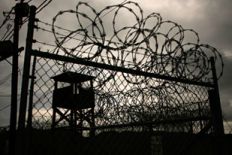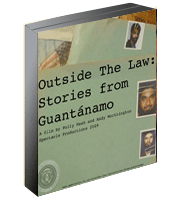The Last Iraqi In Guantánamo, Cleared Six Years Ago, Returns Home
15.6.09
 Last Thursday, while all eyes were focused on the arrival of four Uighurs from Guantánamo on Bermuda’s balmy shores — and while a few other commentators, myself included, noted that Guantánamo’s youngest prisoner, Mohammed El-Gharani, had been released to his family’s home country of Chad — only one journalist, James Warren of the Atlantic, noticed that another prisoner, an Iraqi named Jawad Jabbar Sadkhan al-Sahlani, had also been released. Warren spoke to his lawyer, Jeffrey Colman of Jenner & Block, who told him, bluntly, “He should never have been there.”
Last Thursday, while all eyes were focused on the arrival of four Uighurs from Guantánamo on Bermuda’s balmy shores — and while a few other commentators, myself included, noted that Guantánamo’s youngest prisoner, Mohammed El-Gharani, had been released to his family’s home country of Chad — only one journalist, James Warren of the Atlantic, noticed that another prisoner, an Iraqi named Jawad Jabbar Sadkhan al-Sahlani, had also been released. Warren spoke to his lawyer, Jeffrey Colman of Jenner & Block, who told him, bluntly, “He should never have been there.”
Al-Sahlani (whose last name had never been registered by the Pentagon) had explained in Guantánamo that he had been seized by mistake. In his Combatant Status Review Tribunal in 2004 (a one-sided administrative review board convened to assess whether, on capture, he had been correctly designated as an “enemy combatant” who could be held without charge or trial), he said that he and his family had left Iraq because of the intolerable living conditions under Saddam Hussein, and that they had gone first to Iran, and then to the UN in Pakistan, where he sought asylum.
When it became apparent that the UN would not be able to help him, he said that he planned to return to Iran and was told that the easiest route back was through Afghanistan. However, the guides he traveled with left him in Kabul, and he said that he then approached Mullah Nitham Eddine, who worked for the police, and, after explaining that he and his family were immigrants, was found an Afghan family to live with.
He added that he then moved with his family to a village near Mazar-e-Sharif, in northern Afghanistan, which was where he had been for most of the three and a half years he had spent in Afghanistan, working mainly as a taxi driver, but also, on occasion, selling fuel and working as a mechanic. He explained that, in 2002, he was arrested at his home by an Afghan commander, and was then sold to the Americans, who took him to Kandahar and then Guantánamo.
Despite this coherent and plausible explanation, al-Shalani was obliged, in his tribunal, to point out the huge discrepancy between the allegations against him and his own account. Although he is a Shiite Muslim, which explains why he fled the oppression of Saddam Hussein, as the Shiite majority was persecuted by Iraq’s dictator, it was alleged that in Iraq he had worked for the Amin Emergency Response Group, who were “responsible for tracking down people opposed to Saddam Hussein, and torturing and/or killing [them].” It was also alleged that, in Afghanistan, he was a Taliban commander, a Taliban recruiter, an interrogator for the Taliban in Mazar-e-Sharif, in charge of ten to 15 other interrogators, that he was “heavily involved in the heroin trade for the Taliban,” and that he received funds from Osama bin Laden that were funneled through a Saudi charity operating in Afghanistan.
In a rather contradictory allegation, it was claimed that he recruited a group of his own fighters, provided them with weapons, communications equipment and vehicles, and “intended to sell his fighting group’s service[s] to the highest bidding warlord in Afghanistan.” According this scenario, if a recruit refused to join his group, he was turned over to the Taliban as a spy, although, in defiance of the “highest bidder” scenario mentioned above, it was also alleged that he and his group fought with the Taliban against the Northern Alliance on the front lines. Perhaps the most ludicrous allegation of all — given his background and his religion — was a claim that he had “operated as a conduit between the Taliban in Mazar-e-Sharif and Saddam Hussein.”
In response, he denied ever working for the Taliban at all, and explained that, while he was in Mazar-e-Sharif, he had, in fact, worked occasionally for the Northern Alliance, repairing vehicles for a representative of General Rashid Dostum, the leader of the Alliance’s Uzbek faction in northern Afghanistan, who he also helped, after the US-led invasion began, by “pointing out Taliban locations.” He added, poignantly, “I put my life, my wife’s life and the life of my children in danger in order to help the Northern Alliance.”
When asked for his opinions about the allegations against him, he said that he thought they had come about because of disagreements with other prisoners who had told lies about him. He pointed out that he was being held in Camp V (one of the prison’s maximum-security blocks) for protection against attacks by other prisoners, because he was a Shiite Muslim (in contrast to the prison’s Sunni majority), and because “I cooperated with interrogators.” He added that he had suffered a broken arm after he was attacked by a Saudi prisoner, and blamed two particular interrogators for the incident, saying that they had deliberately left the two of them in a room together.
As the examples of other Shiite prisoners has shown — primarily other Iraqis, whose bitter experiences of false allegations I reported when four Iraqi prisoners were released in the dying days of the Bush administration — the conflict in Guantánamo between Sunni agitators and Shiites was very real, and, to be honest, reflects badly on the US authorities, who should have realized that both the radical Sunni fanatics of al-Qaeda and the radical Sunni fanatics of the Taliban (who were responsible for several massacres of Afghanistan’s Shiite minority, the Hazara) would never have accepted a Shiite Muslim into their midst.
In one of al-Sahlani’s annual review boards (convened to assess whether, having been found to be an “enemy combatant,” he still posed a threat to the US or its allies), two Iraqi witnesses provided further explanations of the Sunni/Shiite conflict, and, in addition, one pointed out that al-Sahlani had also been targeted by two particular prisoners who were known within Guantánamo as notoriously unreliable informants.
Arkan al-Karim, one of the men released in January, refuted allegations that al-Sahlani had threatened other prisoners, pointing out that it was he who had been threatened, and another, Abbas al-Naely (also released in January), who had met al-Sahlani in Afghanistan, first provided a spirited defense of his character, describing him as a man devoted to his family, who was “not a political man nor a religious man nor a war man and he is a peaceful person,” and adding, “I was in Mazar-e-Sharif addicted to hashish but in spite of that he helped me,” and then explained that the allegations against him had resulted from a disagreement with two particular prisoners whose false allegations plagued countless prisoners in Guantánamo: Ali al-Tayeea, another Iraqi (also released in January), and Yasim Basardah, a Yemeni, profiled in the Washington Post in February, whose habeas petition was granted by a judge the following month.
From the above, it is, I hope, abundantly clear that Jawad al-Sahlani’s story exemplifies many of Guantánamo’s most persistent problems: prisoners handed over to US forces by opportunists seeking the handsome bounty payments being offered for “al-Qaeda or Taliban suspects,” who were then labeled as “enemy combatants” without any screening whatsoever, and were victimized by the lies of other prisoners (whether under duress, through bribery or because they had severe mental problems), which were then regarded as the truth by credulous interrogators and administrators.
On his release, al-Sahlani’s lawyer, Jeffrey Colman, reiterated the story told by his client in Guantánamo, but added that in 2003 “senior US military leaders and the head of the Department of Defense Criminal Investigation Task Force” had “recommended he be released.” Colman was at a loss to explain why it had taken so long. He said he had asked, but had “gotten no answers,” and added that the delay was also inexplicable because, unlike other prisoners who cannot be returned to their home countries because they face the risk of torture, al-Sahlani “wanted to go home from the start.”
Colman was scathing about the way Guantánamo was run. In his 35-year career, he said, he had “represented clients in the most dire legal and physical circumstances imaginable,” visiting maximum-security prisons and working for death row prisoners in Illinois and Georgia, but representing men held at Guantánamo had been the “most depressing, difficult, frustrating experience of my legal career. Never have I seen the kind of disrespect for the attorney-client relationship as at Guantánamo.” He added, “It’s unlike any other institution. There’s a level of isolation and hopelessness unlike anything I have ever seen.” He also explained that it was almost impossible for the men in Guantánamo to understand what was happening to them. “How do you say to a client that we’ve been talking about the same question — does a court have the power to hear your case — for six years?” he asked.
Al-Sahlani’s ordeal is now at an end — and I can only hope that his optimism about how he will be treated in Iraq is justified — but there has, as yet, been no explanation of why it took the Obama administration five months to release him, nor why his release took place when it did. I don’t mean to end on a sour note, but it appears, from a comment made by Colman, that the new government was motivated less by an impulse to correct a long-standing injustice, than by a fear that it would be shown up in a courtroom.
As Colman explained, he was only informed on May 15 that al-Sahlani had been cleared for release by the Obama administration’s inter-departmental task force, which is reviewing the cases of all the remaining prisoners, and he added that his release from Guantánamo “occurred as Jenner & Block lawyers were preparing for a habeas corpus hearing that was scheduled to start on June 18 before Washington D.C. federal district court judge Rosemary Collyer.”
That, I have to conclude, is more than a little convenient.
 Andy Worthington is the author of The Guantánamo Files: The Stories of the 774 Detainees in America’s Illegal Prison (published by Pluto Press, distributed by Macmillan in the US, and available from Amazon — click on the following for the US and the UK). To receive new articles in your inbox, please subscribe to my RSS feed, and also see my definitive Guantánamo prisoner list, published in March 2009.
Andy Worthington is the author of The Guantánamo Files: The Stories of the 774 Detainees in America’s Illegal Prison (published by Pluto Press, distributed by Macmillan in the US, and available from Amazon — click on the following for the US and the UK). To receive new articles in your inbox, please subscribe to my RSS feed, and also see my definitive Guantánamo prisoner list, published in March 2009.
As published exclusively on the website of the Future of Freedom Foundation.
See the following for articles about the 142 prisoners released from Guantánamo from June 2007 to January 2009, and the eleven prisoners released from February to June 2009, whose stories are covered in more detail than is available anywhere else –- either in print or on the Internet –- although many of them, of course, are also covered in The Guantánamo Files: June 2007 –- 2 Tunisians, 4 Yemenis (here, here and here); July 2007 –- 16 Saudis; August 2007 –- 1 Bahraini, 5 Afghans; September 2007 –- 16 Saudis; September 2007 –- 1 Mauritanian; September 2007 –- 1 Libyan, 1 Yemeni, 6 Afghans; November 2007 –- 3 Jordanians, 8 Afghans; November 2007 –- 14 Saudis; December 2007 –- 2 Sudanese; December 2007 –- 13 Afghans (here and here); December 2007 –- 3 British residents; December 2007 –- 10 Saudis; May 2008 –- 3 Sudanese, 1 Moroccan, 5 Afghans (here, here and here); July 2008 –- 2 Algerians; July 2008 –- 1 Qatari, 1 United Arab Emirati, 1 Afghan; August 2008 –- 2 Algerians; September 2008 –- 1 Pakistani, 2 Afghans (here and here); September 2008 –- 1 Sudanese, 1 Algerian; November 2008 –- 1 Kazakh, 1 Somali, 1 Tajik; November 2008 –- 2 Algerians; November 2008 –- 1 Yemeni (Salim Hamdan) repatriated to serve out the last month of his sentence; December 2008 –- 3 Bosnian Algerians; January 2009 –- 1 Afghan, 1 Algerian, 4 Iraqis; February 2009 — 1 British resident (Binyam Mohamed); May 2009 — 1 Bosnian Algerian (Lakhdar Boumediene); June 2009 — 1 Chadian (Mohammed El-Gharani), 4 Uighurs, 3 Saudis (here and here).












 Who's still at Guantánamo?
Who's still at Guantánamo?

6 Responses
The Last Iraqi In Guantánamo, Cleared Six Years Ago, Returns Home by Andy Worthington « Dandelion Salad says...
[…] Andy Worthington Featured Writer Dandelion Salad http://www.andyworthington.co.uk 15 June […]
...on June 15th, 2009 at 11:45 pm
the talking dog says...
I guess this brings us to eight prisoners released during the Obama Administration; still too slow, but the pace seems to be picking up.
I’m hard-pressed to complain about anyone being released at this point; maybe they’re gearing up for a flood of releases (just as the courts are gearing up for a flood of habeas petitions, and the Kiyemba case looms before the Supreme Court). One can hope.
Of course, as important as the releases are, the gov’t continues to argue for the structure of totalitarianism, so these things might happen in the future…again and again…
The price of liberty is always eternal vigilance, it seems.
...on June 16th, 2009 at 12:24 pm
Andy Worthington says...
Too right about “eternal vigilance,” TD.
I also suspect you’re right about releases coinciding with forthcoming habeas hearings, and hope that does indeed mean that more releases are on the way, even if that will prevent the full details of the government’s empty evidence from being aired in public.
...on June 18th, 2009 at 12:12 pm
Four Men Leave Guantánamo; Two Face Ill-Defined Trials In Italy « freedetainees.org says...
[…] Algerian (Lakhdar Boumediene); June 2009 — 1 Chadian (Mohammed El-Gharani), 4 Uighurs to Bermuda, 1 Iraqi, 3 Saudis (here and here); August 2009 — 1 Afghan (Mohamed Jawad), 2 Syrians to Portugal; […]
...on December 5th, 2009 at 10:14 pm
Innocent Guantánamo Torture Victim Fouad al-Rabiah Is Released In Kuwait « freedetainees.org says...
[…] Algerian (Lakhdar Boumediene); June 2009 — 1 Chadian (Mohammed El-Gharani), 4 Uighurs to Bermuda, 1 Iraqi, 3 Saudis (here and here); August 2009 — 1 Afghan (Mohamed Jawad), 2 Syrians to Portugal; […]
...on December 12th, 2009 at 6:36 am
The Stories Of The Two Somalis Freed From Guantánamo « freedetainees.org says...
[…] Algerian (Lakhdar Boumediene); June 2009 — 1 Chadian (Mohammed El-Gharani), 4 Uighurs to Bermuda, 1 Iraqi, 3 Saudis (here and here); August 2009 — 1 Afghan (Mohamed Jawad), 2 Syrians to Portugal; […]
...on January 29th, 2010 at 8:43 pm